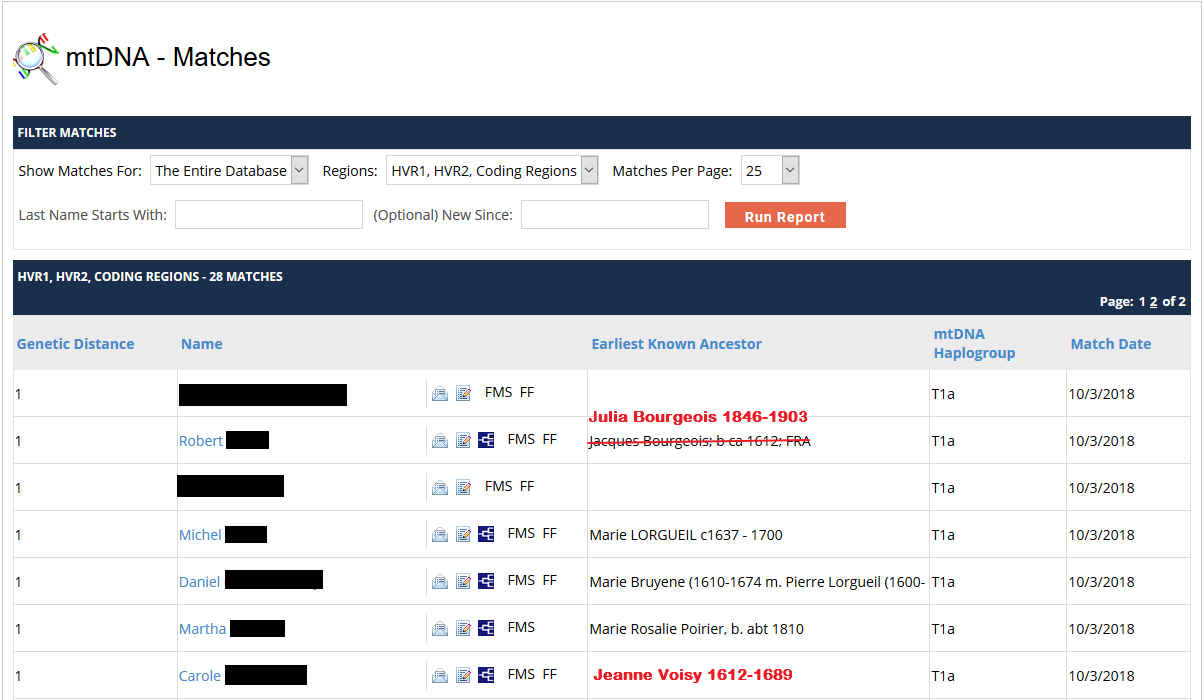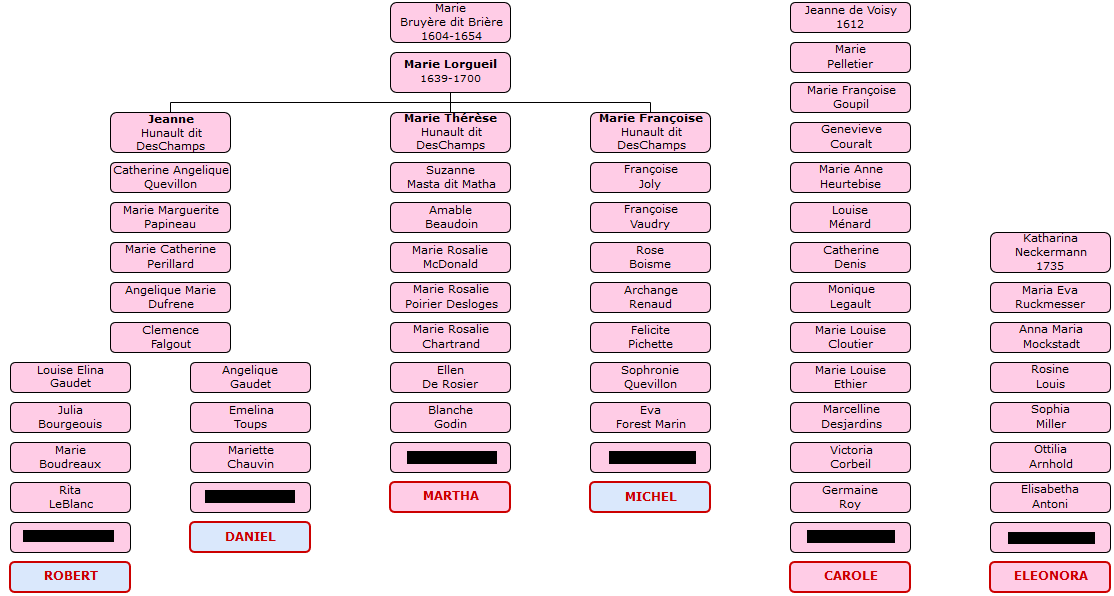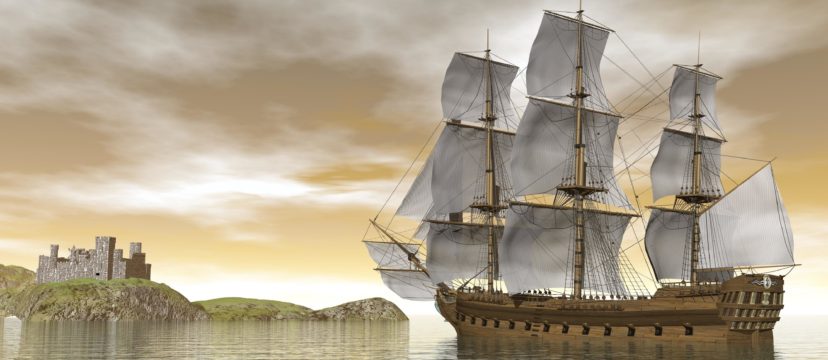Back in the day, when Montreal had 50 inhabitants and was known as fortress Ville-Marie, the existence of today’s megacity seemed to be doomed. The number of French settlers on the Canadian coast steadily decreased due to Iroquois raids, and thus, Governor Paul Chomedey de Maisonneuve was left with no other choice than to sail back to France and to promise to return with at least 100 men.
His promise became known as the chapter “La Grande Recrue” in the French-Canadian history, after his ship had returned with new colonists in 1653, ensuring the survival of the settlement henceforth. In addition to 94 men, 24 years of age on average, 14 young women also came to New France. As it turns out, I’m distantly related to one of them – the then 16-year-old Marie Lorgueil…
Yeah, I was also very surprised to learn about my personal (albeit very distant) connection to the first French Canadians just a few days ago. But let me start from the beginning.
Although I prefer autosomal DNA testing to all other type of tests (due to my primary interest in family relationships over the past 200 years), this year I could not resist FTDNA’s summer sale on a mtDNA full sequence test. Thanks to 23andme and LivingDNA, I already knew that I belonged to the haplogroup T1. However, for a more detailed information, as well as a list of DNA matches on your matrilineal branch, you need to order a mtDNA test from FTDNA.
A full sequence test of one’s mitochondrial DNA means to encode all 16569 base pairs and to compare the results with all other individuals in the database. Mitochondrial DNA, or mtDNA for short, accounts for only about one percent of the total DNA and has been passed down from mothers to children for thousands of years, but carried on to the next generation by daughters only.
Now and then – this term can span hundreds or thousands of years – DNA replication results in a mutation, which is nothing other than a copying error that is then passed on to the following generations. When any two individuals are compared, a smaller number of mutations in their mtDNA indicates a closer relationship. As the mutations are extremely rare, it is thus possible to look much further back in time than with autosomal DNA.
Due to the specific mutations in their mtDNA, all humans can be assigned into different mitochondrial haplogroups. As some of the haplogroups are older than others, a tree with many branches emerges, all of which are leading to the most distant ancestor on the matrilineal branch of all humans living today – the mitochondrial Eve. Some haplogroups are typical for certain regions, which allows to draw conclusions about human migration.
Mitochondrial DNA is not suitable for determining a relationship between close relatives, because even two people with an exact mtDNA match can have a common ancestor in the Middle Ages. On the other hand – since a mutation can occur at any time – it can sometimes happen that mtDNA of close relatives such as mother/child or siblings does not fully match. (The most famous case is probably the one of Blaine Bettinger, whose mtDNA does not fully match his own mother’s.)
The more detailed analysis of mitochondrial DNA by FTDNA reveals not only which particular haplogroup you belong to, but also the names of all individuals in the database with the same matrilineal lineage. Since there are also differences within a haplogroup, DNA matches are presented in “genetic distances”. A genetic distance of 1 means that mtDNA of two individuals differs only by a single mutation in the 16569 base pairs. Matches with a genetic distance of 4 or more are not displayed in the database.
With the help of church records and censuses, I was able to trace my most distant matrilineal ancestor to one of the first settlers on the Volga – my great-great-great-great-great-great grandmother Katharina Neckermann from Mainz, born in 1735. Unfortunately, I was not yet able to continue her line in Germany – as of now, there is only a single trace leading to Königshofen. (But which Königshofen, a city in Germany or the suburb of Strasbourg?? This remains a mystery, as I do not have any documents for my ancestor prior to her immigration.)
When my mtDNA results came back at the beginning of October, I learned that I belonged to the T1a haplogroup, a subgroup of T1.
And here are my matches:

The first thing that struck me, was that the matrilineal ancestors of my “closest” matches were all French. And second, that two of the matches, Michel and Daniel, seemed to have traced their matrilineal branches back to the same woman or family, respectively. After comparing their family trees, I was astonished to discover that Michel and Daniel were 9C1R! Thus, it was very likely that they did not know each other before and worked on their pedigrees separately. And the DNA test confirmed their research in a truly wonderful way!
My curiosity was aroused and I checked the family trees of Martha, Carole and Robert as well (instead of his earliest matrilineal ancestor, he accidentally entered his earliest ancestor of all). The matrilineal branch of Martha’s pedigree came to an end with Marie Rosalie Poirier, born in 1810. Carole did not list her earliest ancestor, but there was a family tree linked to her profile. She was able to track down her matrilineal branch to Jeanne Voisy, born in 1612. With a little research on my own in the databases of Ancestry, I managed to expand the lines of Martha and Robert further back and came to a very interesting result:

The matrilineal ancestors of four of my matches all go back to the same woman – Marie Bruyère dit Brière, born 1604 in France. One of the sources about her daughter Marie Lorgueil mentioned something about “La Grande Recrue” and caught my interest. After a few clicks on Google, I suddenly found myself in the midst of Canadian founding history! Marie Lorgueil was one of the first women to leave France for a new life in Canada and became the matrilineal ancestor of hundreds of thousands of French Canadians – four of which have turned up on my mtDNA match list! How fascinating!
And what about Carole and me? Our lines are not incorrect; even though we are not descended from Marie Lorgueil like the others, we must have a common matrilineal ancestor with her, who we still need to look for further back in time. Most likely in France. Most certainly more than 400 years ago.
The fact that four descendants of three different daughters of Marie Lorgueil are a genetic match to each other is a very strong evidence for the accuracy of their paper research. Since the testees are very distant cousins, an autosomal test would not have been very useful in this case. There would have been a small possibility for an autosomal match between Robert and Daniel, but not with the others.
Herein lies the biggest advantage of a mtDNA test for genealogists – to confirm or reject theories of a more distant relationship on the matrilineal branch. For example, to confirm my descent from Katharina Neckermann, I would need to find a female, who is descended from her other daughter, Elisabeth Ruckmesser.
This has already been done for a long time with historical personalities. Philip Mountbatten, the consort of Queen Elizabeth II of England, was a key figure in the identification of the remains of the Russian Imperial family found in 1997. Czarina Alexandra was the sister of his maternal grandmother, Victoria of Hesse-Darmstadt. (Their maternal grandmother was none other than Queen Victoria herself.) Likewise, the bones of Richard III (1452-1485), found under a parking lot in Leicester in 2012, were confirmed by a mtDNA test of his living relatives, descendants of his sister Anne of York.
History itself can be personalized in a certain way by taking a mtDNA test (the same applies for a Y-DNA test). In our history lessons we learn the names of many significant people without ever thinking that these people could have been our distant relatives or ancestors. According to the calculation of the mathematician Joseph Chang in 1999, every European today has a common ancestor who lived around 1400. Therefore, when we research our family tree further back in time, our ancestors stop doubling with every generation at some point. The ancestors become fewer again, because sooner or later, some people begin to show up several times in our pedigree – because there were fewer people back then than there are today.
So the question is not whether you are related to an important historical person, but to whom – Petrarch, Marie Antoinette or Abraham Lincoln? Their mtDNA haplogroups and the ones of many other famous names are known today. How about a DNA test?
Last updated on July 19th, 2023. Today I accidentally stumbled upon the baptism record for Marie Lorgueil. She was born in Bordeaux on June 15th, 1634. The record was found by Gilles Brassard. (No, not the famous quantum physicist, but a fellow Québécois now living in Paris.)
Last updated on Jan 27th, 2023. All sentences containing the words “direct female ancestor” or “direct maternal line” were replaced with “matrilineal ancestor” or “matrilineal branch”.
Views: 1645


Hi Eleonora, I am Carole!!!!! T1a – Jeanne Voisy!
Hi Carole! Happy to see you here! 🙂